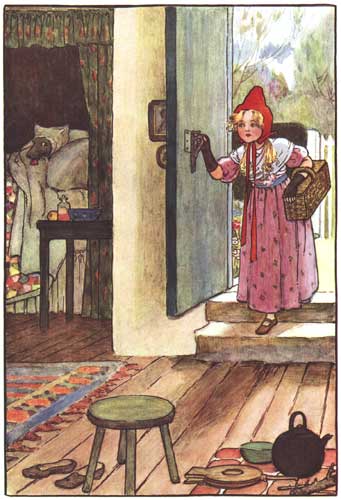
Image source: Sur La Lune Fairy Tales
I’ve talked about Perrault’s Red Riding Hood before, but I wanted to visit the Grimm’s version this week, in honor of Banned Books Week.
The Grimm version differs slightly from Perrault’s. First, obviously is the girl’s nickname, Little Red Cap, but in other ways as well. Little Red Cap is of course on her way to grandma’s house, this time carrying wine and cake. She meets the wolf along the way and he persuades her to stop and pick some flowers, while he rushes ahead eats grandma and disguises himself as the old woman. When Little Red Cap gets to the house we have the standard and answers, what big eyes you have and so on. The wolf eats Little Red Cap, but here the girl and her grandma get a happier ending. A hunter comes by, sees the wolf asleep on the bed after his feast, and cuts the wolf open, freeing Little Red Cap and grandma. Red Cap and the hunter fill the wolf’s open stomach with rocks, so when it awakes and can’t run and falls down dead.
Then all three were delighted. The huntsman drew off the wolf’s skin and went home with it; the grandmother ate the cake and drank the wine which Red-Cap had brought, and revived, but Red-Cap thought to herself, “As long as I live, I will never by myself leave the path, to run into the wood, when my mother has forbidden me to do so.”
It goes on to say that another wolf tried to eat the girl on a later trip to grandma’s house, but the two tricked it into drowning itself in the water trough.
In 1989, two California school districts banned Grimm’s Fairy Tales because of “Little Red Riding Hood.” Was it the sexual innuendo? The violence? The cross-dressing wolf? No, it was banned because Little Red Cap has in her basket wine for grandma. Obviously this condones the use of alcohol. Not that any reason is a good one to ban Little Red Riding Hood, but that seems the silliest of the lot. What do you think? And the Grimms’ version is not as blatant or gruesome as Perrault’s, in my opinion, but it’s certainly more well-known.
You can read the Grimms’ “Little Red Cap” several places on-line, including here. The version I read was from Household Tales by Jacob and Wilhelm Grimm, Margaret Hung, translator, published in 1884.
Thursday’s Tales is a weekly event here at Carol’s Notebook. Fairy tales, folktales, tall tales, even re-tellings, I love them all.

The illustration is beautiful.
I can’t believe they’d ban Little Red Riding Hood. What really irks me is that they ban perfectly good books while our young people are watching violence and drinking, etc on television. It just doesn’t make sense. On another note, I love that illustration.
Oh, the things that are on television are ridiculous. And if I remember right, it used to be you were pretty safe before like 9:30 or 10, but that’s no longer the case at all. Of course, in theory parents are in control of the TV.
Hm, in what other way does it differ? Now I need to read the other version cos this one sounds like the normal one to me
Yeah, this is the more familiar one. In Perrault’s they just get eaten up and the sexual innuendo is more noticeable.
I love that illustration.
I can’t believe the wine was the only problem. Of course this fairy tale is far more complex than it seems – perhaps teachers were too stupid to answer questions of their more inquisitive pupils and then decided to ban the whole story and get some peace and quiet? ;p
I do think if you get too deep into it it’s certainly not a story for five year-olds, but yeah, the wine seems like the least of the issues to me.
I didn’t know they banned this one because of the wine in her basket! How ridiculous.
That’s a lovely illustration.
When you mentioned wine, my banning-senses started tingling. Wine was probably the standard drink in Grimms’ time. What in the world do they make of all the wine drinking in the Bible?
I think it had something to do with the fact that it “revived” her at the end. But yeah, it’s funny how wine in one instance is fine but not in another.
It was nice to read your post. Thank you for posting this piece!